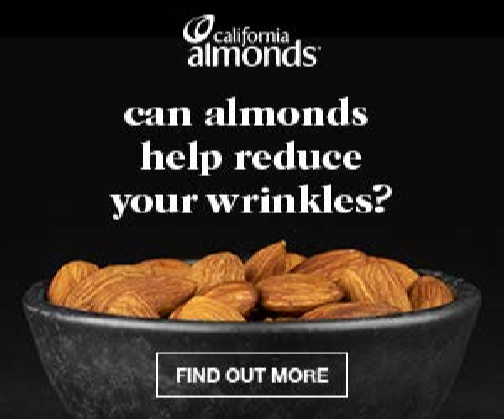Anti-wrinkle regimens abound, but emerging research suggests that one delicious addition to consumer’s skincare routine may be found in their pantries instead of their makeup kits: almonds.
 Funded by the Almond Board of California (ABC) and conducted by UC Davis researchers, results from this emerging research suggest that a daily snack of almonds (two servings per day) in place of other nut-free snacks improved measures of wrinkle width and severity in postmenopausal women.1 The study is the first of its kind to examine almonds’ effects on skin health.2 (More information on the research may be found below at “Study at a Glance.”)
Funded by the Almond Board of California (ABC) and conducted by UC Davis researchers, results from this emerging research suggest that a daily snack of almonds (two servings per day) in place of other nut-free snacks improved measures of wrinkle width and severity in postmenopausal women.1 The study is the first of its kind to examine almonds’ effects on skin health.2 (More information on the research may be found below at “Study at a Glance.”)
While a larger and longer-term follow-up study is underway, once this preliminary research was published the Almond Board’s Global Marketing team quickly went to work in sharing the study’s results with consumers in 11 marketing regions across the globe. To educate U.S. and Mexico consumers, specifically, about the study’s findings, ABC’s North America marketing team created a campaign encompassing digital strategy, social media and public relations efforts.
For the digital and social component of the campaign, the North American team placed advertisements on Facebook, Instagram, Accuweather, Pandora, Entertainment Tonight Live and other sites. Each advertisement highlights the natural beauty of almonds and directs viewers to the Almond Board’s consumer website – Almonds.com – to learn more about the study.
In terms of public relations efforts, several influential newspapers, journals and other outlets have featured this research in their publications. Notable pickup includes that from The Miami Herald, Real Self, Practical Dermatology and the West Palm Beach, FL, broadcast station WFLX-TV. ABC also hosted a media tour in November, and during the tour, Registered Dietitian Keri Gans spoke to journalists about the research results as well as future studies that ABC will fund in this area.
Finally, the Almond Board will be attending dermatology and dietician conferences in the U.S. throughout 2020 to share the emerging research with key scientists and influencers in those sectors.
If you have questions about this North America marketing campaign, please contact ABC’s Jenn Freeman at jfreeman@almondboard.com.

Study at a Glance:
The Study: 28 healthy, postmenopausal women with Fitzpatrick skin type 1 (always burns, never tans) or 2 (usually burns, tans minimally) were randomly assigned to either an intervention or a control group. Almonds were provided as 20% of total daily calorie intake for the intervention group (340 calories/day on average), about 2 one-ounce servings. The control group consumed a calorie-matched nut-free snack in place of almonds daily: cereal bar, energy bar or pretzels. All participants were advised not to consume any nuts or nut-containing products over the course of the study (except for the almond snack for the intervention group). They otherwise were advised to continue their usual daily energy intake.
After a four-week dietary wash-out period, participants were randomized to one of the two study groups detailed above. Study visits occurred at baseline, 4 weeks, 8 weeks, 12 weeks and 16 weeks.
Facial wrinkles were assessed using high-resolution facial photography and validated 3-D facial modeling and measurement at baseline, 8 weeks and 16 weeks. Skin barrier function was assessed by measurement of sebum production and transepidermal water loss (TEWL).
Results:
- Photographic image analysis showed that the almond group had significant reductions in wrinkle width and severity, by 10 and 9%, respectively, compared to the control group at the 16-week time point (P<0.02).
- There were no significant differences in sebum production between groups after 8 and 16 weeks.
- There were no significant differences between groups in transepidermal water loss (TEWL) from baseline after 8 and 16 weeks.
- There were no significant changes from baseline in the skin barrier function (P=0.65) between the almond and control groups relative to baseline after 16 weeks.
Study Limitations: Aging is a long-lasting process so the findings from this 16-week study may be difficult to reproduce and generalize to extended periods of time. Skin-aging is also multi-factorial in nature and although certain groups were excluded (i.e., those with a smoking history), there is variance in aging confounders, such as frequency of UV light exposure and emotional stress, which were outside the scope of the study. This study was limited to cosmetic evaluation, as no measurements were made regarding collagen production. Study did not evaluate disease or younger subjects, so results are limited to otherwise healthy post-menopausal females. In addition, this was a pilot study with a limited number of participants. Future studies should expand to a larger recruitment pool.
Conclusion: Results of this pilot study suggest that daily consumption of almonds may play a role in reducing wrinkle severity in post-menopausal women. The outcomes warrant future studies with expanded population groups and additional evaluations for signs of skin aging.
[2] Foolad N, Vaughn AR, Rybak I, Burney WA, Chodur GM, Newman JW, Steinberg FM, Sivamani RK. Prospective randomized controlled pilot study on the effects of almond consumption on skin lipids and wrinkles. Phytotherapy Research. 2019;1–6. https://doi.org/10.1002/ptr.6495


